INSTITUT SUPERIEUR D'ANTHROPOLOGIE
INSTITUTE OF ANTHROPOLOGY
ONLINE COURSES / COURS A DISTANCE
SUMMER TERM : JULY 2014
REGISTER NOW
GRECE –  Astypalea- The concept of love during the ancient Greek times isn’t that different from nowadays. The only change is the way people used to express their feelings. A lovestruck person today may use graffiti to express passion for his beloved, while ancient Greeks inscribed love messages on stones. According to Ethnos, ancient love inscriptions dating back to the early 6th and the late 5th centuries B.C., were recently discovered in Astypalea. Spirals, shapes of ships, tools in triangular shapes were mostly drawn by the Neolithic inhabitants of Astypalea. One of the first findings of the Professor of Prehistoric Archaeology, Andreas Vlachopoulos, was rock paintings located in Vathi at the Pirgos Peninsula and date back to 4th-3rd millennium B.C. In 2013, more unexpected findings were discovered, which present an aspect of privacy of the ancient Greek inhabitants in the early 6th and late 5th centuries B.C. The Secretary General of the Archaeological Society, Vasilios Petrakos, made extensive reference to two love inscriptions that were discovered which depict two phalluses from the right angle.
Astypalea- The concept of love during the ancient Greek times isn’t that different from nowadays. The only change is the way people used to express their feelings. A lovestruck person today may use graffiti to express passion for his beloved, while ancient Greeks inscribed love messages on stones. According to Ethnos, ancient love inscriptions dating back to the early 6th and the late 5th centuries B.C., were recently discovered in Astypalea. Spirals, shapes of ships, tools in triangular shapes were mostly drawn by the Neolithic inhabitants of Astypalea. One of the first findings of the Professor of Prehistoric Archaeology, Andreas Vlachopoulos, was rock paintings located in Vathi at the Pirgos Peninsula and date back to 4th-3rd millennium B.C. In 2013, more unexpected findings were discovered, which present an aspect of privacy of the ancient Greek inhabitants in the early 6th and late 5th centuries B.C. The Secretary General of the Archaeological Society, Vasilios Petrakos, made extensive reference to two love inscriptions that were discovered which depict two phalluses from the right angle.
http://greece.greekreporter.com/2014/06/04/ancient-love-inscriptions-in-astypalea/?
ROYAUME UNI – Linn -Archaeologists hope to uncover some of King’s Lynn’s rich nautical history with a survey of the Ouse.hey will be spending a weekend looking for anchors, cannons and the remains of a wrecked ship amid the river mud at low tide. Lynn was a key port in the medieval Hanse - a powerful alliance of medieval merchants trading their wares around the Baltic and North Sea. Centuries ago, the town also boasted its own shipyards and a whaling fleet, which hunted the giant mammals in the seas off Greenland, towing them back to Lynn to be boiled up for lamp oil. The survey, on June 28 and 29, is being run by the Lynn-based Marriott’s Warehouse Trust, True’s Yard and the West Norfolk Archaeological Society.
http://www.edp24.co.uk/news/searching_for_the_secrets_that_lie_under_the_river_in_king_s_lynn_1_3626853
EGYPTE – 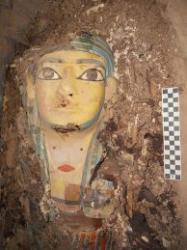 Assouan - A new tomb that contains nine mummies was discovered in southern Aswan by Spanish archaeologists.The tomb is said to belong to the Late Period (664 BCE-332 BCE) in Ancient Egyptian history, according to an official statement released by the Ministry of Antiquities on Sunday. The tomb is believed to belong to two ruling families that lived in Aswan during the Middle Kingdom of Pharaonic Egypt, according to the research conducted by the Spanish expedition. A wooden coffin was also discovered. The preserved mummy inside is believed to be a person who lived during the Late Period. Minister of Antiquities Mohamed Ibrahim announced that the discovery was made by Spanish archaeologists in cooperation with the Ministry of Antiquities in the area of Koba El-Hawa in Aswan. Several tombs of the rulers of Aswan during the period between 2000-1700 B.C. were discovered in this area. Ibrahim said the area includes other tombs belonging to Upper Egyptian rulers during the Middle and Old Kingdom. One of the famous tombs belongs to “Hor Khof”, who is known as the only ruler whose autobiography was documented on the walls of his tomb. A tomb for King “Hakanab I”, whose temple was discovered behind the Museum of Aswan in the beginning of the 20thcentury, was also found there. Alejandro Jimmenz, head of the Spanish expedition, said that the archaeologists have performed full documentation on the mummy of King “Haka Abe III”, which they have discovered previously during earlier visits to Egypt. Mummies for the members of the king’s family were also discovered, including that of woman named “Ja Ot Anktot”, and another mummy, the king’s brother, “Sarnbut”.
Assouan - A new tomb that contains nine mummies was discovered in southern Aswan by Spanish archaeologists.The tomb is said to belong to the Late Period (664 BCE-332 BCE) in Ancient Egyptian history, according to an official statement released by the Ministry of Antiquities on Sunday. The tomb is believed to belong to two ruling families that lived in Aswan during the Middle Kingdom of Pharaonic Egypt, according to the research conducted by the Spanish expedition. A wooden coffin was also discovered. The preserved mummy inside is believed to be a person who lived during the Late Period. Minister of Antiquities Mohamed Ibrahim announced that the discovery was made by Spanish archaeologists in cooperation with the Ministry of Antiquities in the area of Koba El-Hawa in Aswan. Several tombs of the rulers of Aswan during the period between 2000-1700 B.C. were discovered in this area. Ibrahim said the area includes other tombs belonging to Upper Egyptian rulers during the Middle and Old Kingdom. One of the famous tombs belongs to “Hor Khof”, who is known as the only ruler whose autobiography was documented on the walls of his tomb. A tomb for King “Hakanab I”, whose temple was discovered behind the Museum of Aswan in the beginning of the 20thcentury, was also found there. Alejandro Jimmenz, head of the Spanish expedition, said that the archaeologists have performed full documentation on the mummy of King “Haka Abe III”, which they have discovered previously during earlier visits to Egypt. Mummies for the members of the king’s family were also discovered, including that of woman named “Ja Ot Anktot”, and another mummy, the king’s brother, “Sarnbut”.
http://www.dailynewsegypt.com/2014/06/04/9-pharaonic-mummies-discovered-southern-egypt/?
ROYAUME UNI – 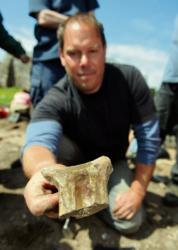 - Holme Cultram Abbey - The dig is being held at Holme Cultram Abbey, Abbeytown, near Wigton, with the team from Grampus Heritage and Training hoping to find out more about the 900-year-old abbey’s past as a monastery. Although the dig only started on Monday, archaeologists have already found items that are hundreds of years old including tiled floors, drainage systems, jug handles and bones from shellfish and oysters, believed to be from between the 12th to 16th centuries.A small excavation two years ago showed that the site was used in medieval times for iron production and during that dig the team found half a wooden bowl as well as preserved timbers and fragments of leather. This summer the team are focusing on looking for the refectory area where the monks would have eaten.
- Holme Cultram Abbey - The dig is being held at Holme Cultram Abbey, Abbeytown, near Wigton, with the team from Grampus Heritage and Training hoping to find out more about the 900-year-old abbey’s past as a monastery. Although the dig only started on Monday, archaeologists have already found items that are hundreds of years old including tiled floors, drainage systems, jug handles and bones from shellfish and oysters, believed to be from between the 12th to 16th centuries.A small excavation two years ago showed that the site was used in medieval times for iron production and during that dig the team found half a wooden bowl as well as preserved timbers and fragments of leather. This summer the team are focusing on looking for the refectory area where the monks would have eaten.
http://www.newsandstar.co.uk/news/1.1140366?
THAILANDE – 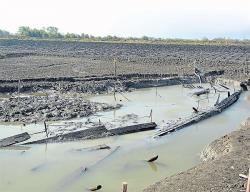 Samut Sakhon - The discovery of a 1,000-year-old Arab-style ship in Samut Sakhon may give a clearer picture of life and trade during the Dvaravati period. Now buried several metres deep under the muddy ground in a former shrimp farm in Samut Sakhon province, a millennium-old ship once sailed many oceans of the world. The vessel, 25m long, had travelled from faraway lands to transport a variety of goods to cities on this part of the Earth before it sank here during the Dvaravati period (6th-11th centuries). The excavation of this ship began in December last year and is still under way and is now about 10% completed.Many artefacts were discovered inside the ship. Most of them are earthenware and stoneware, both unglazed from domestic kilns and glazed from China, along with some other kinds from unknown places. The The rest consists of coconut fruits, toddy palms, hundreds of betel nuts, rice, halved coconut shells, wood resin, a horn, fish bones, animal bones and plant seeds.
Samut Sakhon - The discovery of a 1,000-year-old Arab-style ship in Samut Sakhon may give a clearer picture of life and trade during the Dvaravati period. Now buried several metres deep under the muddy ground in a former shrimp farm in Samut Sakhon province, a millennium-old ship once sailed many oceans of the world. The vessel, 25m long, had travelled from faraway lands to transport a variety of goods to cities on this part of the Earth before it sank here during the Dvaravati period (6th-11th centuries). The excavation of this ship began in December last year and is still under way and is now about 10% completed.Many artefacts were discovered inside the ship. Most of them are earthenware and stoneware, both unglazed from domestic kilns and glazed from China, along with some other kinds from unknown places. The The rest consists of coconut fruits, toddy palms, hundreds of betel nuts, rice, halved coconut shells, wood resin, a horn, fish bones, animal bones and plant seeds.
http://www.bangkokpost.com/lifestyle/family/413237/up-from-the-deep
IRLANDE – 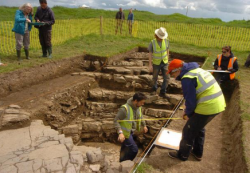 Tlachtga - Human remains, thought to be that of of a 3,000 year old baby have been found during archaeological works at Tlachtga, on the Hill of Ward, Athboy. The remains were found at the base of a 1.5m ditch at the site. It is believed the fully-intact skeleton is of a baby between seven-10 months old but it is not thought the child was the victim of any human sacrifice on the ritualistic site. The remains will now be taken to the School of Archaeology at University College Dublin for further examination. Describing it as "an exciting find," lead archaeologist on the site, Dr Stephen Davis, said: "We may never know what caused the death of the child. The skeleton probably dates back 3,000 years and was found on the bedrock at the base of a 1.5m ditch". However, he didn't believe the baby's death was caused by any form of human sacrifice. The remains were found during a three-week excavation on Tlachtga - most commonly held to have been the first site to celebrate the feast of Samhain – Hallowe'en. Surveys already carried out using airborn laser and geophysical techniques have already revealed the area to have been a "key ritual site", according to Dr Davis who now hopes the latest findings will "strengthen the case of more funding" for further excavations.
Tlachtga - Human remains, thought to be that of of a 3,000 year old baby have been found during archaeological works at Tlachtga, on the Hill of Ward, Athboy. The remains were found at the base of a 1.5m ditch at the site. It is believed the fully-intact skeleton is of a baby between seven-10 months old but it is not thought the child was the victim of any human sacrifice on the ritualistic site. The remains will now be taken to the School of Archaeology at University College Dublin for further examination. Describing it as "an exciting find," lead archaeologist on the site, Dr Stephen Davis, said: "We may never know what caused the death of the child. The skeleton probably dates back 3,000 years and was found on the bedrock at the base of a 1.5m ditch". However, he didn't believe the baby's death was caused by any form of human sacrifice. The remains were found during a three-week excavation on Tlachtga - most commonly held to have been the first site to celebrate the feast of Samhain – Hallowe'en. Surveys already carried out using airborn laser and geophysical techniques have already revealed the area to have been a "key ritual site", according to Dr Davis who now hopes the latest findings will "strengthen the case of more funding" for further excavations.
http://www.meathchronicle.ie/news/roundup/articles/2014/06/04/4030710-athboy-discovery-could-be-3000-year-old-baby/
PAKISTAN - 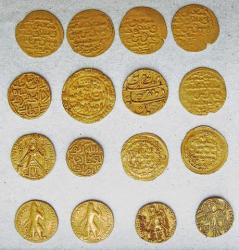
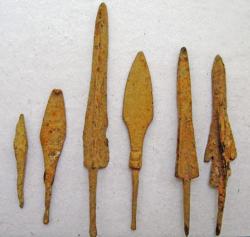 Customs officials at the Benazir Bhutto International Airport made one of their biggest hauls of ancient coins and artifacts when they caught a China-bound passenger trying to smuggle out more than 2,000 rare items, including 16 well-preserved gold coins. The recovered items were sent to the Department of Archaeology and Museums (DOAM) for verification. The department, in its preliminary report, verified that most of the recovered coins were antique and dated back to the Islamic, Kushan, Sultanate period, Mughal, Hindu Shahi, Sassanid and Sikh dynasties. The department of archaeology took about 10 days to verify more than 2,000 coins and some 110 iron spear and arrow heads, surgical items, copper bells, seals, rings and items made from semi-precious stones. The most fascinating are the 16 gold coins from the Islamic and Kushan periods. Equally well preserved and beautifully carved are the 1,000 silver coins of Mughal, Hindu Shahi, Sassanid and Sikh dynasties. The catch also contained some 270 copper coins of Sultanate period besides coins from the fairly recent British Empire and the United States. Holding a 250 AD Kushan period gold coin, the expert described the figure of the king known as Vasudev. The other side of the coin has an impression of Lord Shiva holding a trident. Unlike the coins from the Kushan period with impressions of kings and gods, the gold coins belonging to the Islamic period carried only text and had the names of Sultan Firuz Shah Tughlaq (1309-1388). Another carried the name of Masud who was the son of Mahmud of Ghaznavi. The expert seemed more fascinated with the coin with the name of Mughal Emperor Aurangzeb Alamgir.
Customs officials at the Benazir Bhutto International Airport made one of their biggest hauls of ancient coins and artifacts when they caught a China-bound passenger trying to smuggle out more than 2,000 rare items, including 16 well-preserved gold coins. The recovered items were sent to the Department of Archaeology and Museums (DOAM) for verification. The department, in its preliminary report, verified that most of the recovered coins were antique and dated back to the Islamic, Kushan, Sultanate period, Mughal, Hindu Shahi, Sassanid and Sikh dynasties. The department of archaeology took about 10 days to verify more than 2,000 coins and some 110 iron spear and arrow heads, surgical items, copper bells, seals, rings and items made from semi-precious stones. The most fascinating are the 16 gold coins from the Islamic and Kushan periods. Equally well preserved and beautifully carved are the 1,000 silver coins of Mughal, Hindu Shahi, Sassanid and Sikh dynasties. The catch also contained some 270 copper coins of Sultanate period besides coins from the fairly recent British Empire and the United States. Holding a 250 AD Kushan period gold coin, the expert described the figure of the king known as Vasudev. The other side of the coin has an impression of Lord Shiva holding a trident. Unlike the coins from the Kushan period with impressions of kings and gods, the gold coins belonging to the Islamic period carried only text and had the names of Sultan Firuz Shah Tughlaq (1309-1388). Another carried the name of Masud who was the son of Mahmud of Ghaznavi. The expert seemed more fascinated with the coin with the name of Mughal Emperor Aurangzeb Alamgir.
http://www.dawn.com/news/1110057/china-bound-passenger-held-with-over-2000-rare-ancient-coins
ROYAUME UNI – 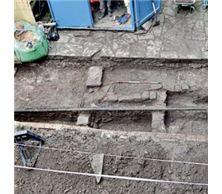 Chester - Part of a skeleton has been unearthed close to a housing block for vulnerable people. A spine was discovered by archaeologists at the Almshouses in Blue Coat Square, off Upper Northgate Street in Chester, where a medieval hospital was once located. It is the fifth body discovered at the site, but many more are believed to remain hidden beneath the old Hospital of St John the Baptist, founded in 1190 but demolished in the 15th century.
Chester - Part of a skeleton has been unearthed close to a housing block for vulnerable people. A spine was discovered by archaeologists at the Almshouses in Blue Coat Square, off Upper Northgate Street in Chester, where a medieval hospital was once located. It is the fifth body discovered at the site, but many more are believed to remain hidden beneath the old Hospital of St John the Baptist, founded in 1190 but demolished in the 15th century.
http://www.chesterfirst.co.uk/news/134305/archaeologists-discover-spine-of-skeleton-in-chester.aspx
ROYAUME UNI - -  – Belfast - An investigation is under way into claims that a rare Stone Age site near Belfast has been badly damaged. The Department of Environment (DoE) is working to establish if planning restrictions at the Ballymaglaff construction site in Dundonald were broken.Historian Peter Carr, who discovered the Ballymaglaff site in 1984, said it dated from the Early Mesolithic period, 8,800-9,800 years ago
– Belfast - An investigation is under way into claims that a rare Stone Age site near Belfast has been badly damaged. The Department of Environment (DoE) is working to establish if planning restrictions at the Ballymaglaff construction site in Dundonald were broken.Historian Peter Carr, who discovered the Ballymaglaff site in 1984, said it dated from the Early Mesolithic period, 8,800-9,800 years ago
http://www.bbc.com/news/uk-northern-ireland-27686165?
ROYAUME UNI – Lincoln -A medieval stone sculpture of the Virgin Mary and Christ has been discovered in an archaeological dig before construction on parts of the Lincoln University Technical College. Artefacts dating back to the Roman period have also been found at the site. The Virgin Mary stone sculpture was discovered behind a stone wall on the Lincoln UTC site, close to Lincoln Cathedral. The discoveries were made during a digging part of the project, which is being worked on by building contractors Willmott Dixon.
http://www.lincolnshireecho.co.uk/Virgin-Mary-Christ-stone-sculpture-discovered/story-21180859-detail/story.html?
EGYPTE – Assouan - Spanish experts have discovered an intact funeral chamber containing nine mummies in the tomb of governor Haqaib III, which dates back to the Middle Kingdom (2050-1750 BC), in the southern Egyptian city of Aswan."The team has found the tomb of a Middle Kingdom governor for the first time in 100 years," project director Alejandro Jimenez told Efe.The group of experts from the University of Jaen in Spain and Egypt's Supreme Council of Antiquities completed this year the excavation of the governor's tomb, which had been discovered previously, and brought together "all the pieces" to confirm that this was the tomb of Haqaib III.Pictures of the governor had also been found on Elephantine Island in the Nile River near the city of Aswan.Later studies, however, revealed that his appearance had been idealised in those representations, since this high official suffered from scoliosis, or lateral curvature of the spine, and had an early death at age 30 in living conditions the archaeologist described as "very tough".The deceased governor was of Nubian origin, judging by some personal possessions that were found, including a dagger made with the technique used by that ethnic group in southern Egypt.In that same tomb, located in the Qubbat al-Hawa area, the experts found a chamber with sarcophagi containing nine mummies of the Late Period of Ancient Egypt (724-343 BC)."These were the mummified bodies of eight humans and a crocodile," Jimenez said.
http://www.newindianexpress.com/world/Spanish-Archaeologists-Find-Nine-Mummies-in-Egypt/2014/06/03/article2260839.ece?